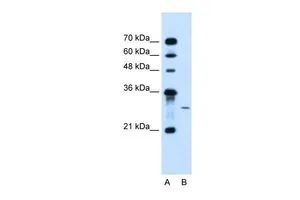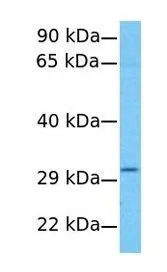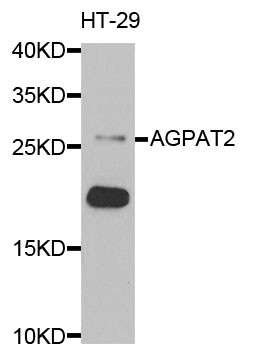
WB analysis of Jurkat cells using GTX46672 AGPAT2 antibody at 5.0microg/ml. Lane A : marker Lane B : Jurkat cells
AGPAT2 antibody, C-term
GTX46672
ApplicationsWestern Blot
Product group Antibodies
TargetAGPAT2
Overview
- SupplierGeneTex
- Product NameAGPAT2 antibody, C-term
- Delivery Days Customer9
- ApplicationsWestern Blot
- CertificationResearch Use Only
- ClonalityPolyclonal
- Concentration0.5-1 mg/ml
- ConjugateUnconjugated
- Gene ID10555
- Target nameAGPAT2
- Target description1-acylglycerol-3-phosphate O-acyltransferase 2
- Target synonyms1-AGPAT2, BSCL, BSCL1, LPAAB, LPAAT-beta, LPLAT2, 1-acyl-sn-glycerol-3-phosphate acyltransferase beta, 1-AGP acyltransferase 2, 1-acylglycerol-3-phosphate O-acyltransferase 2 (lysophosphatidic acid acyltransferase, beta), lysophosphatidic acid acyltransferase-beta, lysophospholipid acyltransferase 2, testicular tissue protein Li 143
- HostRabbit
- IsotypeIgG
- Protein IDO15120
- Protein Name1-acyl-sn-glycerol-3-phosphate acyltransferase beta
- Scientific DescriptionThis gene encodes a member of the 1-acylglycerol-3-phosphate O-acyltransferase family. The protein is located within the endoplasmic reticulum membrane and converts lysophosphatidic acid to phosphatidic acid, the second step in de novo phospholipid biosynthesis. Mutations in this gene have been associated with congenital generalized lipodystrophy (CGL), or Berardinelli-Seip syndrome, a disease characterized by a near absence of adipose tissue and severe insulin resistance. Alternate transcriptional splice variants, encoding different isoforms, have been characterized. [provided by RefSeq, Jul 2008]
- Storage Instruction-20°C or -80°C,2°C to 8°C
- UNSPSC12352203







